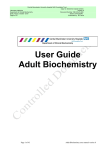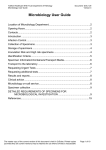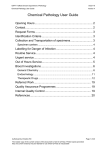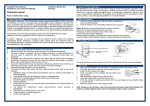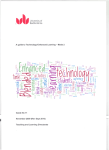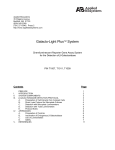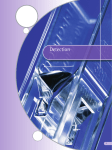Download Operating Instructions for the Bilirubin Application Routine Version
Transcript
Operating Instructions for the Bilirubin Application Routine Version 1.1 (March 2012) Copyright: ascanis OHG, Überlingen Germany, 2010-2012 Document version 1.1 Contact: [email protected] Tel +49 700 27226471 Introduction The application routine is designed to perform the determination of xanthochromia in cerebrospinal fluid (CSF) with a spectrometric measurement. This is a procedure increasingly applied in clinical analysis replacing a simple visual inspection of CSF. Its eventual aim is to make a diagnosis of subarachnoid hemorrhage. The Bilirubin Application Routines are dedicated software within a report template that is embedded to the VISIONlite software. VISIONlite is a general-purpose UV/Vis-application software package for Thermo Scientific spectrophotometers. Thus the routine can be operated with various Thermo Scientific UV/Vis and Vis-spectrophotometers of the GENESYS, Helios and Evolution series. Furthermore, the measurement system can be applied for other photometric measurements like general spectrum scanning, rate measurements for enzyme activity determinations or quantitative measurements. Two versions of the routine are supplied: • Bilirubin auto with an automated adaptation of the linear tangential spectrum baseline, • Bilirubin manual with a manual procedure for the spectrum baseline. The CD additionally contains the extended routines: • Bilirubin auto e as Bilirubin auto, but with 2 additional checks that are not part of the Guidelines. • Bilirubin manual e as Bilirubin manual, but with 2 additional checks that are not part of the Guidelines. The additional checks are described in the section Evaluation Procedure Details at the end of this documentation. These routines are also available with a result output in the Danish language. Important: The routines have undergone extensive testing, including on-site beta-tests. However it remains the user´s responsibility to continuously observe instrument performance and an appropriate operation and sample handling as well as to always check plausibility of the generated results. Spectrophotometers Basically, the routine requires a Thermo Scientific spectrophotometer that covers the visible spectral range. However, 2 further requirements should be obeyed: - The test is based on the evaluation of small absorbance differences. In order to limit the influence of accidental instrument signal noise, a noise specification of typically <0.0005 A should be given. See also section Remarks. Bilirubin Application Routine - The test evaluates an absorption band with a band half width of about 30 nm. For that, common practice recommends using a spectrophotometer with a spectral bandwidth of < 3 nm to correctly read the band´s peak height. See also section Remarks. Thermo Scientific spectrophotometers that conform to the above requirements amongst others: GENESYS 10S UV/Vis BioMate 3S Evolution 60(S) Evolution 300/600 Helios omega/zeta GENESYS 10 UV scanning GENESYS 6 Please note that the Evolution 2xx series spectrophotometers are not compatible to the VISIONlite software so that these instruments cannot be employed. Method Reference The procedure is completely defined by the Revised national guidelines for analysis of cerebrospinal fluid for bilirubin in suspected subarachnoid haemorrhage Produced by the UK NEQAS Specialist Advisory Group for EQA of CSF Proteins and Biochemistry Anne Cruickshank, Peter Auld, Robert Beetham, Gillian Burrows, William Egner, Ian Holbrook, Geoff Keir, Emma Lewis, Dina Pate, Ian Watson and Peter White Ann Clin Biochem 2008; 45: 238–244 Important: Please refer to the above document or its updates for any information on the medical background, further literature, sample preparation and measurement procedure. Due to the use of a modern digitally controlled spectrophotometer and PC-software however, a few adaptations apply, see section Remarks below. The additional checks of the extended versions Bilirubin auto e and Bilirubin manual e are described in the section Evaluation Procedure details. Remarks Decision Tree vs. Text Information In the cited guidelines, the decision tree (Figure 2 of the guidelines) does not fully match to the process described in the text. In cases of discrepancy, the text definitions are applied. Occurrence of Methaemoglobin The guidelines mention that in rare cases Methaemoglobin may be present and can be detected by a peak in the range of 403-410 nm. It is also stated that “when Methaemoglobin is present, the significance of the finding is the same as if Oxyhaemoglobin had been detected.” However the decision tree or the case descriptions do not detail this eventuality. The routine does not check the existence of Methaemoglobin and accordingly does not account for this option in any way. If the user should observe the described appearance, he would be obliged to infer from it. The extended version of the routine however checks for a peak outside the Oxyhaemoglobin peak search range. When a peak is detected, the user is queried, if the peak should be taken for the NOA determination. If the query is accepted, the detected peak is evaluated just as if an Oxyhaemoglobin peak would have been detected. Spectrum Ordinate Mode -2- Bilirubin Application Routine In the cited guidelines, the spectrum ordinate mode is referred to as AU (absorbance units). However, it is more common and also supported by IUPAC to use the unit designation “A” (absorbance). Accordingly, VISIONlite uses the designation “A”. Numerical values for “AU” and “A” are equivalent. Full Scale Deflection The guidelines recommend to use a minimal full scale deflection (FSD) of 0.1 A. The term FSD is common for analog instrumentation, but is not directly applicable for digital instrumentation. The recommendation probably shall facilitate the visual tangential adaptation of the spectral background. However, with the automated adaptation as in this routine, the selected scale definition becomes irrelevant. With a screen presentation of spectra, the ´ordinate expansion` is an option similar to full scale deflection. In VISIONlite the ordinate expansion is handled with the Graph/Y-axis minimum/ maximum parameters. Baseline Measurement The guidelines do not explicitly describe how to perform the baseline run with a blank sample. Typically this is done with a cell that is identical to the cell used for the sample and that is filled with the same solvent as used for the sample. Since a dedicated spectrum baseline is applied, also distilled water or buffer may be appropriate. Spectral Baseline Adaptation The automated adaptation of the spectral background generally gives comparable results to visual procedure, but it is not influenced by subjective errors. However, for data with a higher noise or with spikes, the rigid automated procedure may give other results than foreseen by the visual adaptation. The graphical presentation of the baseline fit allows deciding, if the fit could be inappropriate. In this case, an offline evaluation with manually selected fitting points can be applied, see section Bilirubin manual routine. Measurement Parameters Spectrophotometer Working Range High absorbance values may suffer from increased noise and/or non-linear relation to the sample concentration. This can result in flattened peaks, which may inhibit correct peak detection. The software warns, if the spectrum has absorbance values > 2 A. The working range may be smaller for a specific spectrophotometer or spectrophotometer model and with certain sample characteristics. If feasible, the sample can be diluted or a smaller cell path length be applied to reduce absorbance values. Spectrophotometer Slit Setting The guidelines do not specify a recommended setting of the spectrometer slit (bandpass/spectral bandwidth). The instrument Slit setting has a certain impact on the peak shape and accordingly on the peak height: High setting will decrease the measured peak height: As a rule of thumb, the instrument´s spectral bandwidth should be less than 10 % of the absorption band width to reproduce the correct peak height. Whereas some spectrometers have a fixed slit setting, other higher-performing models allows selecting the slit. A slit setting of 2 nm is a typical selection in UV/Vis-spectroscopy. Slit settings of 3 nm or more may result in a notable decrease of peak height of the absorption band of the NOA absorption in the range of 415 nm, which has a half band width of about 30 nm. Slit settings of 1 nm or less will increase the measurement noise so that the random fluctuation of results increases. -3- Bilirubin Application Routine Digital Data Interval With a digital system, the sampling rate is of relevance for data integrity. Sample spectra with a spectrum data interval of higher than 1 nm do not allow an evaluation with an appropriate accuracy. Therefore a data interval of 1 nm or lower is required for the sample spectra. Spectrophotometer Scan Speed Selection of the spectrophotometer´s scan speed is a compromise between the time required for a sample measurement and the achievable signal-to-noise (S/N) ratio. Especially for low absorbance spectra, a low scan speed is recommended for improving the S/N ratio. VISIONlite Reference For any information about the general purpose VISIONlite software package refer to the printed manual or the online help routine. -4- Bilirubin Application Routine Installation On a Windows based PC, install the VISIONlite software package with Bilirubin application method (provided on a CD) as described in the VISIONlite manual. The dedicated files for the Bilirubin procedure are automatically included in the installation. Note: The Bilirubin application routine is only compatible to VISIONlite version 4.0 or higher. The Bilirubin auto and Bilirubin manual application routines are installed as commands in the Data Handling menu. If you want to utilize the extended routines (see section Introduction) copy the respective *.rpx files from the CD´s /tools directory to the VISIONlite ProgramData directory. Additionally the Help Bilirubin function is made available that presents this operating instruction text on screen. A PDF reader must be installed on the system for that. Also a number of test spectra are installed that allow initial experiments with an offline evaluation. A default measurement method Bilirubin1 is installed for a standard measurement. Connect the spectrometer to the PC. See for details in the VISIONlite manual and the spectrophotometer manual. -5- Bilirubin Application Routine Start-up Power-on the spectrophotometer. Some models require that the instruments be switched to REMOTE mode. See for details in the VISIONlite manual and the spectrophotometer manual. For a pure offline data handling operation however, the instrument does not require to be powered-on. Start the VISIONlite software by clicking the desktop icon or the entry in the VISIONlite program group. The VISIONlite start routine is opened. In the VISIONlite start routine, select the Scan application. The Scan application main window opens. When the communication to the instrument has been established, the live display of ordinate and wavelength in the operating toolbar is activated, showing the current instrument settings and reading. You may use the Data Handling/Help Bilirubin function to open a copy of this Operating Instructions text. -6- Bilirubin Application Routine Standard Operation Method Definition To start a measurement, select the method Bilirubin1 in the Method list box. This is a predefined method that records an absorbance sample spectrum in the 350-600 nm range with a 1 nm data interval. Further parameters like Scan speed or Slit are offered, if available for the specific spectrophotometer, see below. The parameters may be modified and the method is re-stored via the File/Save method command. Note: Typically, the spectrum Data interval can be selected in a range of 0.1 to 5 nm. However, spectra with a data interval higher than 1 nm do not allow readings at the required wavelengths with sufficient accuracy. Therefore only sample spectra with a data interval of 1 nm or less are accepted for evaluation. See also the section Remarks. Note: With some instruments, higher scan speeds are available only with higher data intervals. Do not use these higher scan speeds. Note: The selected Slit setting may have an impact on the peak shape and accordingly on the peak height: See the comments in the section Remarks. Measurement Procedure To start a measurement with the selected method, click the Measure Samples button in the operating toolbar. The Sample information window opens with the fixed sample name Blank. Insert the appropriate blank cell to the spectrophotometer, close the sample compartment and click the Measure button of the Sample information window. Note: Generally, a cell filled with distilled water will be used as a blank. See also the section Remarks. After execution of the baseline run, the Sample information window re-opens. A sample name entry is required. Use the Name and the optional Description text to clearly define the sample for a later inspection. When no information is entered for Description, the patient data are queried with report generation. Insert the sample cell to the spectrophotometer, close the sample compartment and click the Measure button of the Sample information window. After execution of the sample measurement, the spectrum is stored automatically to disk with the given sample name as the file name. This fulfills the guidelines´ recommendations to keep the recorded spectrum (Item 7 of section Standards based on these guidelines). The Sample information window re-opens for the next sample. Close the window to proceed to the data evaluation or proceed as above to measure further samples for a later evaluation, see below. Note: Spectrum absorbance values of > 2 A are considered out of the spectrometer´s working range. A corresponding warning is given in the report, if absorbance values exceed this limit. For a specific instrument however, the working range may even be smaller. Spectrum Evaluation For data evaluation, click the Data Handling/Bilirubin auto function. The linear tangential baseline is added to the graph and the NOA and NBA readings (if applicable) are annotated. With initial use of the Bilirubin application routine, the name of the hospital is queried. This information consecutively is used as the footnote information. See the section Configurations Options for changing this entry. -7- Bilirubin Application Routine Accordingly, the patient name/data are queried. This information is stored as the Description text of the spectrum. The patient data are not queried again, if information is found in the spectrum description. Then the Print preview window opens showing the complete evaluation report. The report shows the recorded spectrum with the adapted tangential baseline. Readings are listed below the graph and the diagnosis results are presented according to the Revised National Guidelines. With the buttons of the Print preview tool bar, the report can be • printed to the printer attached to the PC, • stored as a PDF file. The sample name is applied as the file name, • copied to clipboard. -8- Bilirubin Application Routine Advanced Operation Bilirubin manual routine The Data Handling/Bilirubin manual routine is used as an alternative to the automatic routine. The difference is the manual definition of the linear tangential baseline. A cursor is used to define the 2 wavelengths within the spectrum that constitute the position of the linear tangential baseline. Note: Take care not to move the cursor to the upper or lower limit of the diagram. In this case, the wavelengths selection is considered terminated and the routine is cancelled. If wavelengths outside the allowed wavelength ranges are selected, the routine is cancelled with an appropriate error message. Other details of the routine are identical. Offline Evaluation Spectra that are displayed in the diagram can be re-evaluated. Use the File/Load spectrum function to load a previously recorded spectrum or one of the example test spectra. Click the Data Handling/ Bilirubin auto or Bilirubin manual function for an offline evaluation of the loaded spectrum. The Print preview window is displayed as above. Proceed as described above. Configuration Options Report Footnote The report footnote contains a text entry. With initial use of the Bilirubin application routine, the name of the hospital is queried. This information consecutively is used as the footnote information. The entry can be changed in the Options/Preferences/Printing window. Operator Designation The report notes the operator´s name. This is the current Windows user. As a default the name is generated as the full user name and the PC designation. Use the UserNameMask parameter of the ascapp.cfg configuration file to change the appearance of the operator name. Report definitions The layout and the composition of the report can be configured to a large extent by means of the additional Reporter-SPX software. This includes the sample data queried from the operator, the size, type and position of the graph and texts, the inclusion of additional information or the result designations. Upon request, ascanis can provide for these configurations. Alternatively, the Reporter-SPX software can be purchased. This software opens access to all report configuration options. -9- Bilirubin Application Routine Evaluation Procedure Details The evaluation procedure involves the following steps: 1. A check is made, if absorbance data of the recorded sample spectrum exceed the limit of 2 A. If so, the report receives an according warning message: Data partly exceed the spectrophotometer´s working range. 2. A linear tangential baseline is adapted to the spectrum. The two fit wavelengths are automatically searched in the wavelength ranges 350-400 nm and 430-530 nm. In the report, the two listed baseline tangent points are designated automatic. If there are any spectrum data below the tangential baseline in the range of 350-530 nm the message: Warning: Negative net values – Do you want to set the baseline at 400/430 nm? is given, Select OK to set the baseline points as proposed or quit the evaluation procedure. Alternatively then, the Bilirubin manual routine can be applied. This routine is identical to the automatic routine, but it allows adapting the linear tangential baseline manually. In the report, the two listed baseline tangent points are designated manual. Occurrence of negative net values is documented by an appropriate message in the report. 3. The net bilirubin absorbance (NBA) is calculated as the baseline corrected (net) absorbance at 476 nm (Chalmers calculation). If the linear tangential baseline fits to the spectrum at lower wavelengths than 476 nm, the NBA value is set to 0.00 by definition. The message BP2 < 476 nm (baseline point 2) is added to the NBA value. Extended version only: An additional check is made to compare the average, none baseline corrected data in the range of 450-460 nm to the absorbance at 476 nm: If A476 nm > average (450-460nm), NBA is set to 0.00 and an according remark is issued in the report. Note: Please note that this check is not requested by the National Guidelines, but has been established by user´s experience. 4. A peak is searched in the wavelength range 410-418 nm with a threshold of 0.005 A. Thus a peak is detected, if there is at least one data point on each side of the maximum that has an absorbance of 0.005 A lower than the maximum. Extended version only: If no peak is detected in this wavelength range, but in the range 403-410 nm (methaemoglobin) or in the range 418-430 nm (shifted oxyhaemoglobin absorbance), a query is issued: A peak is found outside the range 410-418 nm at xxx nm. Do you want this peak to be taken as NOA (Y/N)? If a peak has been detected (or has been accepted), the net oxyhaemoglobin absorbance (NOA) is calculated as the baseline corrected (net) peak absorbance. Otherwise the (net) absorbance maximum in the range of 410-418 nm is taken. 5. For some cases, the serum bilirubin (µmol/L ) and CSF protein (g/L) concentration is queried for further differentiation. The values are taken from other measurements. - 10 - Bilirubin Application Routine 6. Cases 4b1 and 4b2 also require the calculation of the Adjusted NBA figure. The Adjusted NBA corrects the Measured NBA with the Predicted Absorbance (PA) at 476 nm of a CSF due to bilirubin. For that, additionally the serum total protein (g/L) concentration is queried. The Adjusted NBA is calculated as: Adjusted NBA = Measured NBA – PA PA = 0.042 * Serum bilirubin * CSF total protein / Serum total protein The following 8 cases are differentiated. For each case, a result text as defined in the guidelines text is output: 1 NBA ≤ 0.007 A and NOA ≤ 0.02 A Result: Bilirubin and oxyhaemoglobin not increased. No evidence to support SAH. 2 NBA ≤ 0.007 A and 0.02 < NOA < 0.1 A Result: Bilirubin not increased. Small amount of oxyhaemoglobin detected. No evidence to support SAH. 3 NBA ≤ 0.007 A and NOA > 0.1 A Result: Oxyhaemoglobin is present in sufficient concentration to impair the ability to detect bilirubin. SAH not excluded. 4a NBA > 0.007 A and ( NOA ≤ 0.02 A or NOA > 0.02 A with no peak detected ) and serum bilirubin concentration ≤ 20 µmol/L and CSF protein concentration ≤ 1 g/L Result: Increased CSF bilirubin. Consistent with SAH. (This would be an unusual pattern within the first week after an event.) 4b1 NBA > 0.007 A and ( NOA ≤ 0.02 A or NOA > 0.02 A with no peak detected ) and serum bilirubin concentration > 20 µmol/L and CSF protein concentration ≤ 1 g/L and Adjusted NBA > 0.007 A Result: Increased CSF bilirubin. Consistent with SAH. (This would be an unusual pattern within the first week after an event.) 4b2 NBA > 0.007 A and ( NOA ≤ 0.02 A or NOA > 0.02 A with no peak detected ) and serum bilirubin concentration > 20 µmol/L and CSF protein concentration ≤ 1 g/L and Adjusted NBA ≤ 0.007 A Result: Increased CSF bilirubin but probably totally accounted for by increase in serum bilirubin. Not supportive of SAH. 4c NBA > 0.007 A and ( NOA ≤ 0.02 A or NOA > 0.02 A with no peak detected ) and CSF protein concentration > 1 g/L Result: Increased CSF bilirubin. This finding may be consistent with: SAH; an increased bilirubin accompanying the increased CSF protein; or other source of CSF blood. Interpret result with caution in relation to SAH especially within first week after event. 5 NBA > 0.007 A and NOA > 0.02 A with peak detected Result: Bilirubin and oxyhaemoglobin increased. Consistent with SAH. - 11 -












